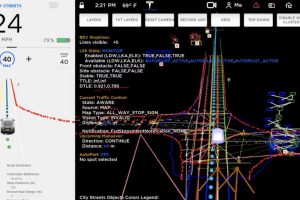Tesla Full Self Driving beta tester Whole Mars Catalog has shared a neat video of Tesla’s FSD Beta v.10.11 as seen from the sky. The three-minute video below shows the trip as seen from a drone.
Tesla CEO Elon Musk recently tweeted that if FSD Beta version 10.11 performed well, Tesla could probably lower the minimum safety score to 95. This version of the software also revealed some key improvements, especially with the detection of vulnerable road users (VRU), which are typically pedestrians and cyclists. Tesla noted that VRU detection improved by 44.9% in the newest update, and this allows its system to reduce “spurious false-positive pedestrians and bicycles.”
Tesla was able to achieve these improvements by increasing the size of its next-generation labelers.
Here’s a quick rundown of Tesla’s FSD Beta v. 10.11 release notes:
— Upgraded modeling of lane geometry from dense rasters (“bag of points”) to an autoregressive decoder that directly predicts and connects “vector space” lanes point by point using a transformer neural network. This enables us to predict crossing lanes, allows computationally cheaper and less error-prone post-processing, and paves the way for predicting many other signals and their relationships jointly and end-to-end.
— Use more accurate predictions of where vehicles are turning or merging to reduce unnecessary slowdowns for vehicles that will not cross our path.
— Improved right-of-way understanding if the map is inaccurate or the car cannot follow the navigation. In particular, modeling intersection extents is now entirely based on network predictions and no longer uses map-based heuristics.
— Improved the precision of VRU detections by 44.9%, dramatically reducing spurious false-positive pedestrians and bicycles (especially around tar seams, skid marks, and raindrops). This was accomplished by increasing the data size of the next-gen autolabeler, training network parameters that were previously frozen, and modifying the network loss functions. We find that this decreases the incidence of VRU-related false slowdowns.
— Reduced the predicted velocity error of very close-by motorcycles, scooters, wheelchairs, and pedestrians by 63.6%. To do this, we introduced a new dataset of simulated adversarial high-speed VRU interactions. This update improves autopilot control around fast-moving and cutting-in VRUs.
— Improved creeping profile with higher jerk when creeping starts and ends.
— Improved control for nearby obstacles by predicting continuous distance to static geometry with the general static obstacle network.
— Reduced vehicle “parked” attribute error rate by 17%, achieved by increasing the dataset size by 14%. Also improved brake light accuracy.
— Improved clear-to-go scenario velocity error by 5% and highway scenario velocity error by 10%, achieved by tuning loss function targeted at improving performance in difficult scenarios.
— Improved detection and control for open car doors.
— Improved smoothness through turns by using an optimization-based approach to decide which road lines are irrelevant for control given lateral and longitudinal acceleration and jerk limits as well as vehicle kinematics.
— Improved stability of the FSD Ul visualizations by optimizing the ethernet data transfer pipeline by 15%.





